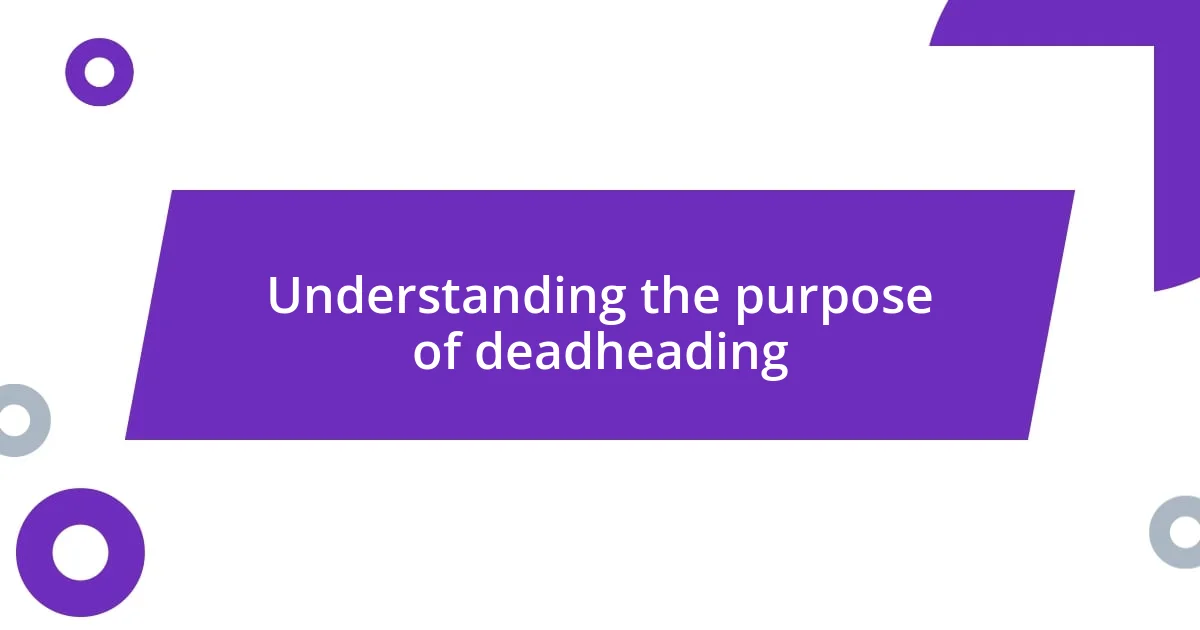Key takeaways:
- Deadheading redirects plant energy from seed production to flower growth, promoting healthier and longer-lasting blooms.
- Effective deadheading techniques include pinching, snipping with scissors, and cutting back foliage to encourage new growth.
- Regular deadheading extends flowering periods, enhances plant vitality, and contributes to a tidier and healthier garden environment.

Understanding the purpose of deadheading
Deadheading is more than just a gardening chore; it’s a way to encourage healthier blooms and a more vibrant garden. When I first started gardening, I was amazed at how quickly my flowers rebounded after removing spent blooms. Have you ever noticed how a plant seems to perk up after a little attention? It’s almost like they’re seeking our encouragement.
One of the key reasons for deadheading is to redirect a plant’s energy from seed production back to flower growth. At one point, I had a rose bush that produced gorgeous blooms all summer long, but it couldn’t compete with a neighboring plant that was more aggressive in its growth. After a solid deadheading session, it felt as if I had given my roses a new lease on life. Watching them flourish again was incredibly rewarding.
Moreover, removing faded flowers helps in preventing fungal diseases and attracts beneficial insects. I once had a patch of petunias that, despite their vibrant colors, fell victim to early wilt. After I removed the dead heads, I noticed a significant improvement in their health. Can you imagine how great it felt to see those colors pop again after a little care? It’s a testament to how our small efforts can lead to big results in our gardens.

Techniques for effective deadheading
When I deadhead, I often find that the technique I use depends on the type of plant I’m tending to. For example, with my petunias, I gently pinch off the spent blooms between my fingers, which feels satisfying as I see the fresh growth beneath. It’s a quick, tactile method that allows me to connect with my plants on a more personal level—like a gentle reminder that they can flourish again with a bit of care.
In contrast, when working with perennials, I prefer to use sharp, clean scissors. Snipping off the dead blooms feels almost ceremonial. It’s as if I’m participating in a ritual of renewal for the garden. This technique helps prevent tearing the plant, and I’ve noticed that my perennials bounce back more robustly when I use this approach. Have you seen how some plants seem to respond better to a little finesse?
Another technique I enjoy is cutting back the foliage alongside deadheading, especially in the late summer. This not only tidies up the overall appearance but also encourages new growth as the season shifts. It’s a practice I stumbled upon during a gardening workshop, and the recommendation really resonated with me. Watching my plants rejuvenate after such a pruning is a joy I can’t quite describe, but perhaps the smiles of my blooming flowers tell the story.
| Technique | Description |
|---|---|
| Pinching | Using fingers to remove spent blooms. |
| Snipping | Utilizing scissors for clean cuts on perennials. |
| Foliage Cutting | Trimming leaves to promote fresh growth. |

Tools to use for deadheading
When it comes to tools for deadheading, I’ve found that the right implements can make a world of difference in my gardening experience. While you can get by with just your fingers, having the proper tools enhances not just efficiency but also the care I provide my plants. I remember the first time I used specialized deadheading shears; the clean cuts left my flowers looking pristine and, remarkably, healthier. It felt like a little upgrade to my gardening toolkit.
Here’s a quick list of useful tools for effective deadheading:
- Pruning Shears: Ideal for perennials; they offer precision and reduce tearing.
- Bypass Pruners: Great for thicker stems, providing a clean cut without crushing the plant.
- Garden Snips: Perfect for delicate blooms, allowing for quick removals while avoiding damage.
- Gloves: Protects hands and gives a better grip when pinching off spent flowers.
- Hand Pruner: A versatile tool for various plant sizes and types, ensuring I have control and comfort.
Using these tools not only helps my garden but also makes the deadheading process more enjoyable. I can often get lost in the rhythm of clipping and snipping, almost as if I’m engaged in a conversation with my plants. Each cut feels like a gentle nudge, encouraging them to thrive and flourish anew.

Benefits of regular deadheading
Regular deadheading comes with an array of benefits that significantly enhance my gardening experience. For starters, it extends the blooming period of my flowers. I’ve noticed that when I regularly remove spent blooms, my plants reward me with more vibrant flowers for a longer stretch. It’s like engaging in a dance where I get to influence the rhythm of their growth—who wouldn’t want to see their garden in full color longer?
Another perk of deadheading is that it helps redirect the plant’s energy. Instead of wasting resources on producing seeds from old blooms, I watch as my plants focus on growing new leaves and flowers. Have you ever felt a sense of satisfaction knowing your care is helping something thrive? That’s exactly how I feel every time I deadhead; it’s like giving my plants a little pep talk, urging them to keep pushing forward.
Finally, deadheading contributes to a tidier garden. I find that clearing away dried flowers not only looks better but also encourages a healthier environment for growth. It’s a small act that carries a big impact, reminding me of my investment in the garden’s overall health. Each time I see those fresh blooms emerge after a deadheading session, it’s a moment of joy, a testament to the relationship I’m nurturing with my plants. How wonderful is it to cultivate both beauty and health in my little corner of the world?














